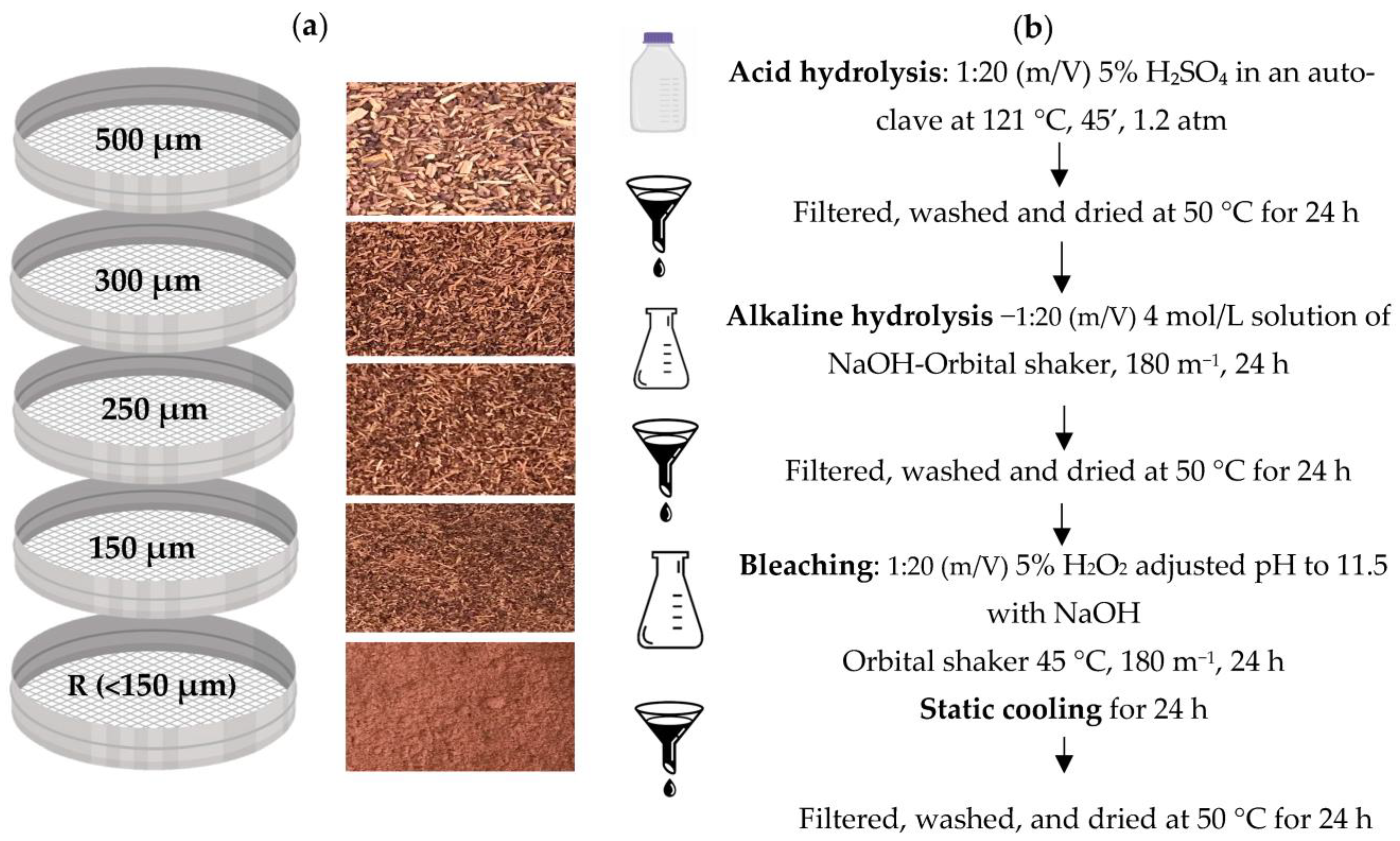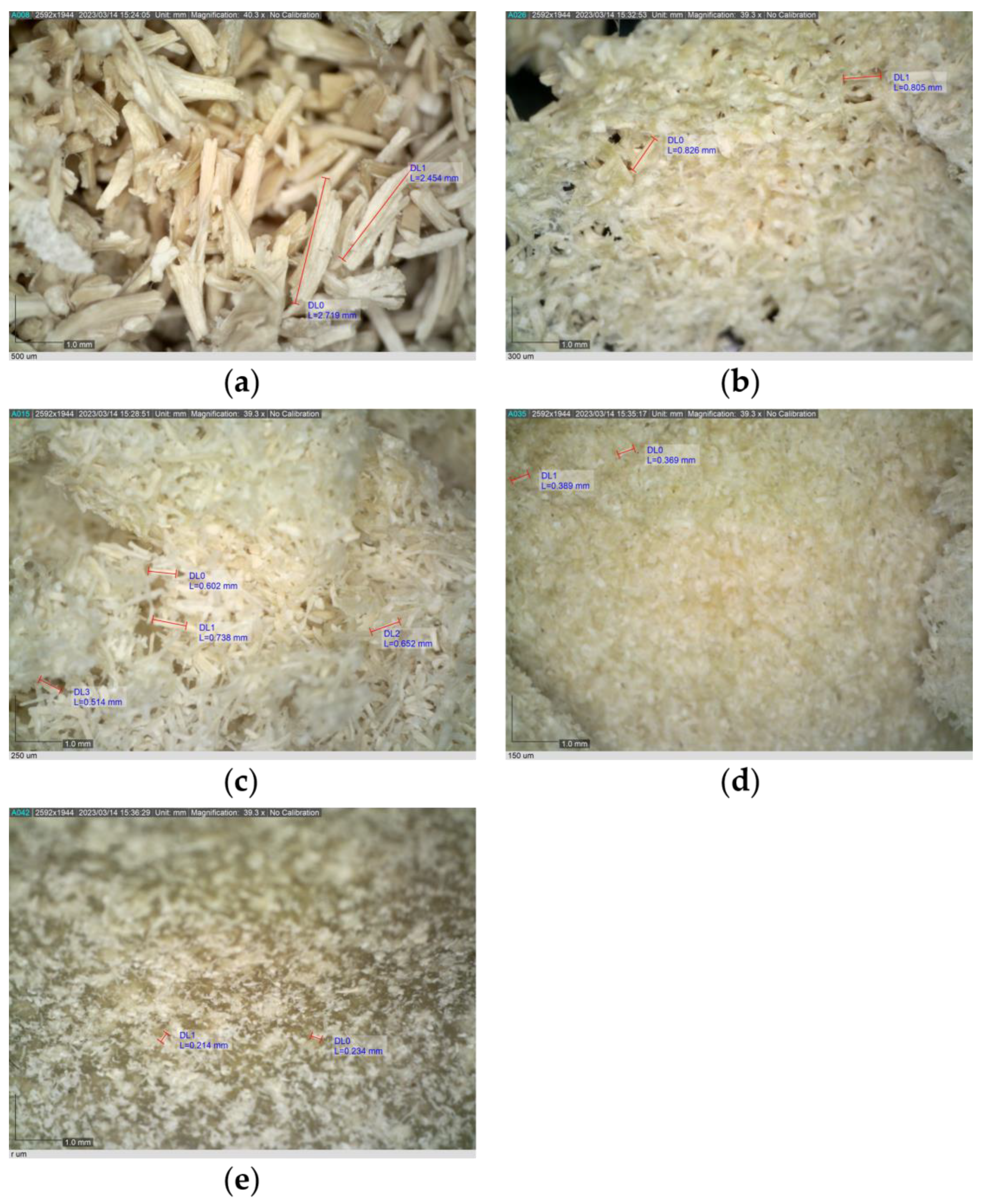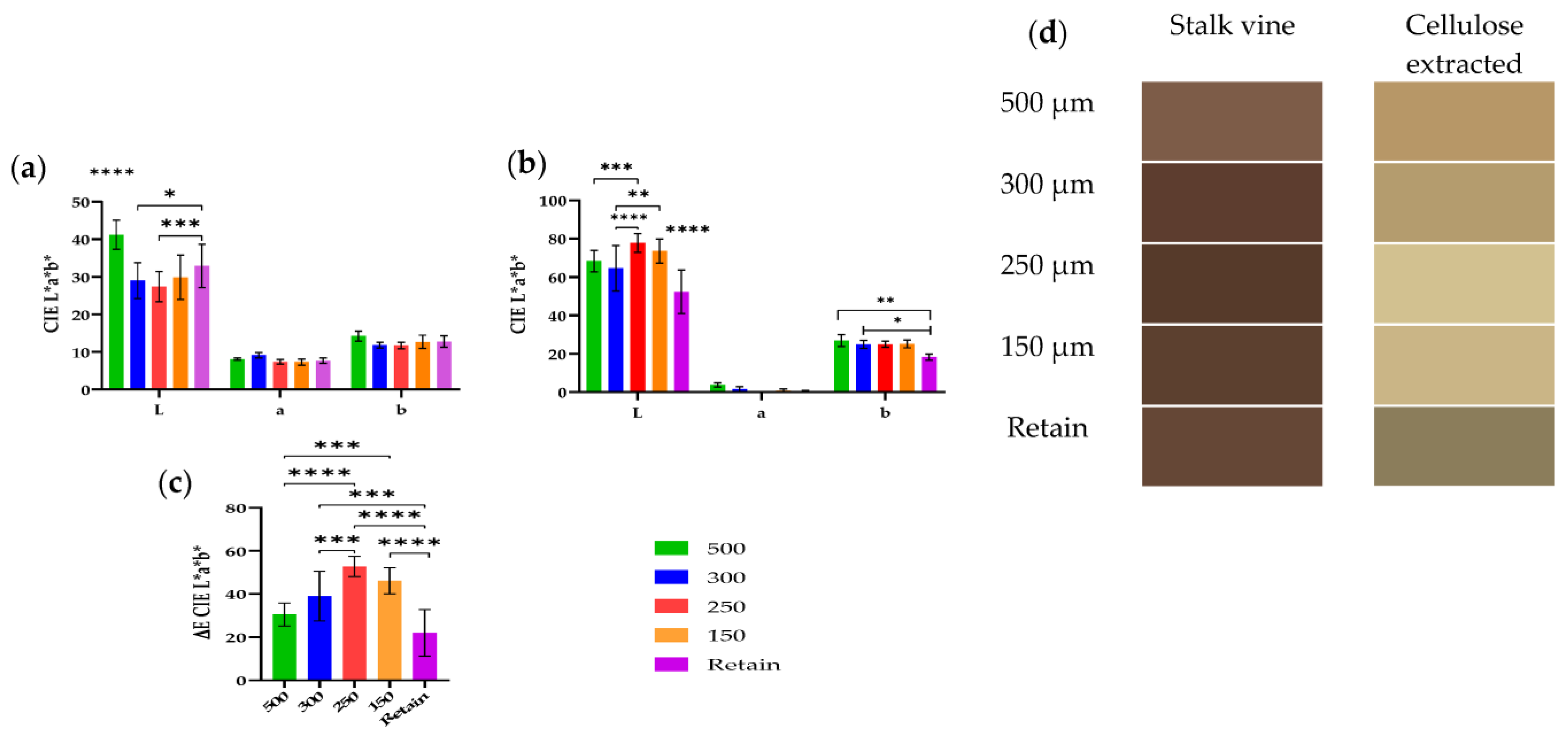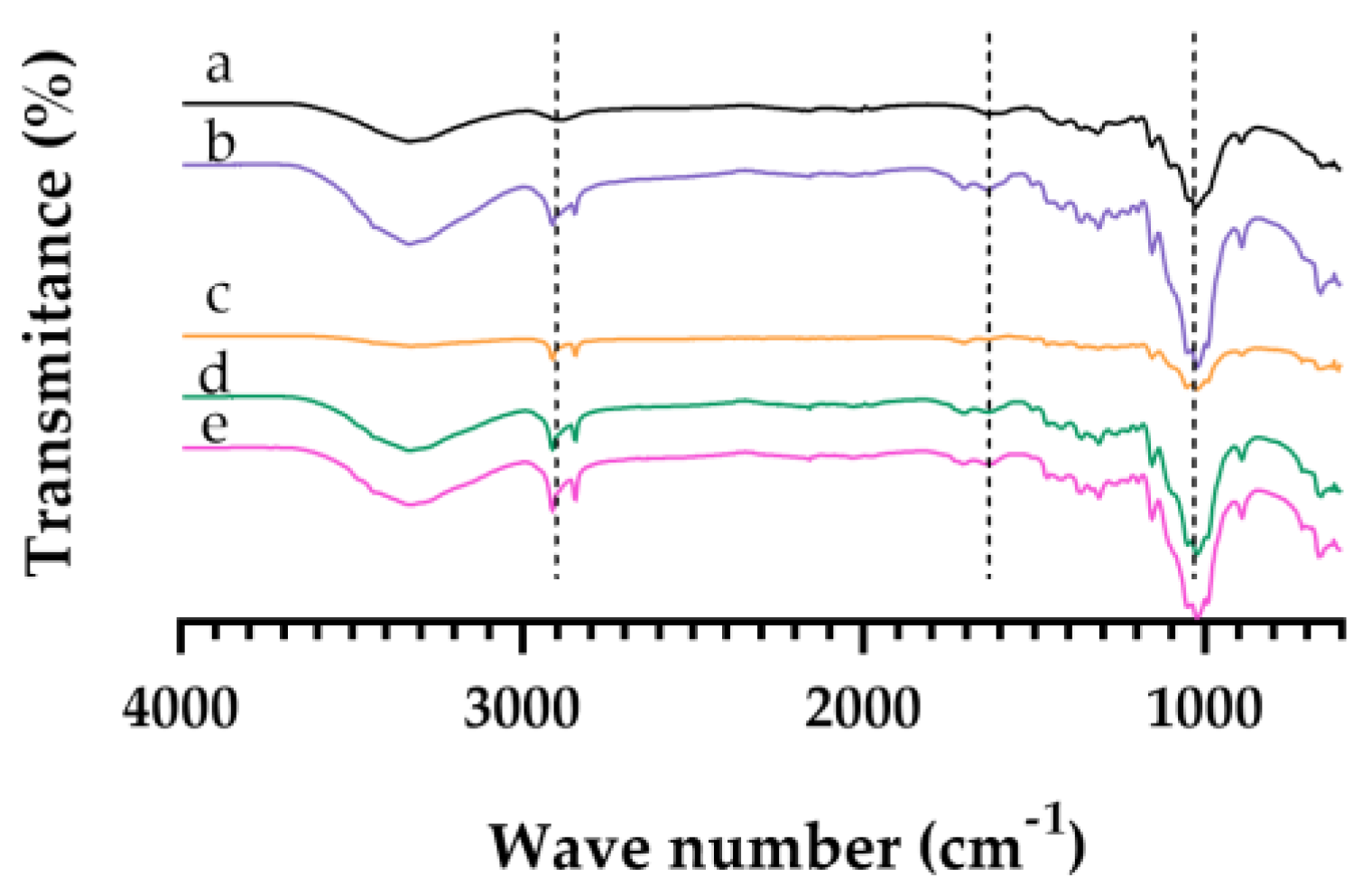Toward a Circular Bioeconomy: Extracting Cellulose from Grape Stalks †
Abstract
:1. Introduction
2. Materials and Methods
2.1. Material
2.2. Cellulose Extraction
2.3. Characterization of Cellulose
2.3.1. Optical Microscopy
2.3.2. Color Analysis
2.3.3. Fourier-Transform Infrared Spectroscopy with Attenuated Total Reflectance (FTIR-ATR)
3. Results
Structural Characterization
4. Discussion
Author Contributions
Funding
Institutional Review Board Statement
Informed Consent Statement
Data Availability Statement
Acknowledgments
Conflicts of Interest
References
- Bhat, K.M.; Rajagopalan, J.; Mallikarjunaiah, R.; Rao, N.N.; Sharma, A.; Bhat, K.M.; Rajagopalan, J.; Mallikarjunaiah, R.; Rao, N.N.; Sharma, A. Eco-Friendly and Biodegradable Green Composites; IntechOpen: London, UK, 2021; ISBN 978-1-83969-081-5. [Google Scholar]
- Vallejo, M.; Cordeiro, R.; Dias, P.A.N.; Moura, C.; Henriques, M.; Seabra, I.J.; Malça, C.M.; Morouço, P. Recovery and Evaluation of Cellulose from Agroindustrial Residues of Corn, Grape, Pomegranate, Strawberry-Tree Fruit and Fava. Bioresour. Bioprocess. 2021, 8, 25. [Google Scholar] [CrossRef]
- Ahmad, B.; Yadav, V.; Yadav, A.; Rahman, M.U.; Yuan, W.Z.; Li, Z.; Wang, X. Integrated Biorefinery Approach to Valorize Winery Waste: A Review from Waste to Energy Perspectives. Sci. Total Environ. 2020, 719, 137315. [Google Scholar] [CrossRef] [PubMed]
- Atatoprak, T.; Amorim, M.M.; Ribeiro, T.; Pintado, M.; Madureira, A.R. Grape Stalk Valorization for Fermentation Purposes. Food Chem. Mol. Sci. 2022, 4, 100067. [Google Scholar] [CrossRef] [PubMed]
- Kaliappan, S.; Velumayil, R.; Natrayan, L.; Pravin, P. Mechanical, DMA, and Fatigue Behavior of Vitis Vinifera Stalk Cellulose Bambusa Vulgaris Fiber Epoxy Composites. Polym. Compos. 2023, 44, 2115–2121. [Google Scholar] [CrossRef]
- Lafka, T.-I.; Sinanoglou, V.; Lazos, E.S. On the Extraction and Antioxidant Activity of Phenolic Compounds from Winery Wastes. Food Chem. 2007, 104, 1206–1214. [Google Scholar] [CrossRef]
- Zhang, H.; Xu, Y.; Yu, S. Co-Production of Functional Xylooligosaccharides and Fermentable Sugars from Corncob with Effective Acetic Acid Prehydrolysis. Bioresour. Technol. 2017, 234, 343–349. [Google Scholar] [CrossRef] [PubMed]
- Liang, J.; Li, Z.; Dai, S.; Tian, G.; Wang, Z. Production of Hemicelluloses Sugars, Cellulose Pulp, and Lignosulfonate Surfactant Using Corn Stalk by Prehydrolysis and Alkaline Sulfite Cooking. Ind. Crops Prod. 2023, 192, 115880. [Google Scholar] [CrossRef]
- Heitz, M.; Carrasco, F.; Rubio, M.; Chauvette, G.; Chornet, E.; Jaulin, L.; Overend, R.P. Generalized Correlations for the Aqueous Liquefaction of Lignocellulosics. Can. J. Chem. Eng. 1986, 64, 647–650. [Google Scholar] [CrossRef]
- Tunc, M.S.; van Heiningen, A.R.P. Characterization and Molecular Weight Distribution of Carbohydrates Isolated from the Autohydrolysis Extract of Mixed Southern Hardwoods. Carbohydr. Polym. 2011, 83, 8–13. [Google Scholar] [CrossRef]
- Lou, C.; Zhou, Y.; Yan, A.; Liu, Y. Extraction Cellulose from Corn-Stalk Taking Advantage of Pretreatment Technology with Immobilized Enzyme. RSC Adv. 2021, 12, 1208–1215. [Google Scholar] [CrossRef] [PubMed]
- Bassani, A.; Fiorentini, C.; Vadivel, V.; Moncalvo, A.; Spigno, G. Implementation of Auto-Hydrolysis Process for the Recovery of Antioxidants and Cellulose from Wheat Straw. Appl. Sci. 2020, 10, 6112. [Google Scholar] [CrossRef]
- Carter, E.C.; Shanda, J.D.; Hirschler, R.; Jost, S.; Luo, M.R.; Melgosa, M.; Ohno, Y.; Pointer, M.R.; Rich, D.C.; Vi’enot, F.; et al. CIE Colorimetry 15; The International Commission on Illumination (CIE): Vienna, Austria, 2018. [Google Scholar]
- Socrates, G. Infrared and Raman Characteristic Group Frequencies: Tables and Charts; John Wiley & Sons: Hoboken, NJ, USA, 2001. [Google Scholar]
- Freixo, R.; Casanova, F.; Ribeiro, A.B.; Pereira, C.F.; Costa, E.M.; Pintado, M.E.; Ramos, Ó.L. Extraction Methods and Characterization of Cellulose Fractions from a Sugarcane By-Product for Potential Industry Applications. Ind. Crop. Prod. 2023, 197, 116615. [Google Scholar] [CrossRef]




| Diameter (µm) | Length (mm) | Yield (%) |
|---|---|---|
| 500 | 2.59 ± 0.13 | 21.98 |
| 300 | 0.82 ± 0.01 | 12.70 |
| 250 | 0.56 ± 0.04 | 7.20 |
| 150 | 0.38 ± 0.01 | 5.74 |
| Retain | 0.22 ± 0.01 | 3.11 |
Disclaimer/Publisher’s Note: The statements, opinions and data contained in all publications are solely those of the individual author(s) and contributor(s) and not of MDPI and/or the editor(s). MDPI and/or the editor(s) disclaim responsibility for any injury to people or property resulting from any ideas, methods, instructions or products referred to in the content. |
© 2023 by the authors. Licensee MDPI, Basel, Switzerland. This article is an open access article distributed under the terms and conditions of the Creative Commons Attribution (CC BY) license (https://creativecommons.org/licenses/by/4.0/).
Share and Cite
Araújo, L.; Machado, A.R.; Pintado, M.; Vieira, E.; Moreira, P. Toward a Circular Bioeconomy: Extracting Cellulose from Grape Stalks. Eng. Proc. 2023, 37, 86. https://doi.org/10.3390/ECP2023-14746
Araújo L, Machado AR, Pintado M, Vieira E, Moreira P. Toward a Circular Bioeconomy: Extracting Cellulose from Grape Stalks. Engineering Proceedings. 2023; 37(1):86. https://doi.org/10.3390/ECP2023-14746
Chicago/Turabian StyleAraújo, Liliana, Adriana R. Machado, Manuela Pintado, Eduarda Vieira, and Patrícia Moreira. 2023. "Toward a Circular Bioeconomy: Extracting Cellulose from Grape Stalks" Engineering Proceedings 37, no. 1: 86. https://doi.org/10.3390/ECP2023-14746
APA StyleAraújo, L., Machado, A. R., Pintado, M., Vieira, E., & Moreira, P. (2023). Toward a Circular Bioeconomy: Extracting Cellulose from Grape Stalks. Engineering Proceedings, 37(1), 86. https://doi.org/10.3390/ECP2023-14746







